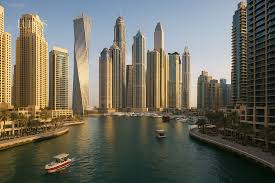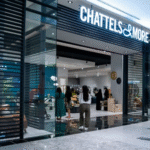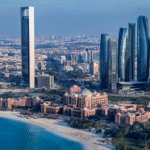Now Reading: Why International Buyers Are Targeting Dubai’s Waterfront Projects
-
01
Why International Buyers Are Targeting Dubai’s Waterfront Projects
Why International Buyers Are Targeting Dubai’s Waterfront Projects

Table of Contents
Imagine stepping onto your balcony, the Arabian Gulf shimmering before you, and knowing your home is not just a slice of paradise but a wealth-building powerhouse. In 2025, Dubai’s waterfront projects Palm Jumeirah, Bluewaters Island, Dubai Harbour, Dubai Islands, and Jumeirah Bay Island are drawing international buyers like moths to a flame.
With 96,000 real estate transactions worth $87 billion in the first half, 58% driven by investors from the UK, India, Russia, and China, these projects offer 100% freehold ownership, a dirham pegged to the U.S. dollar, and no personal income tax, capital gains tax, or annual property taxes. Delivering 6-9% rental yields and 8-15% price appreciation, they outpace London (2-4%) and New York (2-3%). Properties over $545,000 qualify for a 10-year Golden Visa, while smaller units offer 2-year residency.
Fueled by 25 million tourists and a 4% population surge, demand is soaring, but navigating transfer fees, VAT, and 2025 regulations is crucial. This guide explores why international buyers are flocking to waterfront projects like Atlantis The Royal Residences, Bluewaters Residences, Emaar Beachfront, Nakheel’s Waterfront Towers, and Bulgari Resort & Residences, blending lifestyle allure with unmatched returns.
Dubai’s Waterfront Appeal: A Global Magnet
Located 15-40 minutes from Dubai International Airport via Sheikh Zayed Road or water taxis, these waterfront projects offer villas, apartments, and penthouses with vacancy rates at a low 2-3% compared to 7-10% globally. Investors keep 100% of rental income $80,000-$240,000 annually on a $2 million-$4 million property versus $44,000-$144,000 elsewhere after taxes.
Zero capital gains tax saves $100,000-$280,000 on a $500,000-$1 million profit, and no annual property taxes save $20,000-$80,000 yearly, unlike London’s council tax (up to 2%) or New York’s property tax (1-2%). Residential purchases dodge 5% VAT ($100,000-$200,000), and Golden Visa perks enhance residency appeal. From Palm Jumeirah’s iconic beaches to Dubai Islands’ affordability, these projects are fueled by tourism, infrastructure, and exclusivity, making them irresistible to international buyers.
Investing here feels like diving into a sea of opportunity.
No Personal Income Tax: Rentals That Pay Off
These waterfront projects impose no personal income tax, letting you pocket every dirham of rental income, unlike the U.S. (up to 37%) or UK (up to 45%). A $2 million Bluewaters apartment yielding $80,000-$120,000 annually saves $36,000-$48,000 compared to taxed markets. A $4 million Jumeirah Bay villa yielding $160,000-$240,000 saves $72,000-$96,000.
Short-term rentals, boosted by 25 million tourists, require a DTCM license ($408-$816), increasing yields by 15-20% ($12,000-$48,000) on Palm Jumeirah and Bluewaters. Long-term leases need Ejari registration ($54-$136) for stability. Non-compliance risks fines up to $13,612, so proper licensing keeps your profits flowing.
Tax-free rentals feel like a monthly boost to your dreams.
Zero Capital Gains Tax: Profit Without Limits

All waterfront projects offer zero capital gains tax, letting you keep 100% of sale profits. Selling a $2 million Dubai Islands apartment for $2.5 million after 25% appreciation yields a $500,000 tax-free profit, saving $100,000-$140,000 compared to London (20-28%) or New York (20-37%). A $4 million Palm Jumeirah villa sold for $5 million yields a $1 million tax-free gain, saving $200,000-$280,000.
Price growth varies: Palm Jumeirah and Bluewaters lead at 10-15% annually, Dubai Islands and Dubai Harbour hit 8-12%, and Jumeirah Bay reaches 10-15%. A 4% Dubai Land Department (DLD) fee applies on resale ($80,000-$160,000), often split, but tax-free profits amplify returns.
Keeping every dirham feels like a financial victory lap.
No Annual Property Taxes: Lighter Ownership Costs
Unlike global markets where annual property taxes cost $20,000-$80,000 on a $2 million-$4 million property, these waterfront projects have none, easing ownership costs. Maintenance fees vary: $15,000-$25,000 for Palm Jumeirah’s Atlantis The Royal Residences and Bluewaters Residences, $12,000-$18,000 for Dubai Harbour, $10,000-$15,000 for Dubai Islands, and $20,000-$30,000 for Jumeirah Bay’s ultra-luxury villas.
A 5% municipality fee on rentals ($4,000-$12,000) applies, higher on Jumeirah Bay due to premium amenities. These costs are lower than London’s council tax ($40,000-$80,000) or New York’s property tax, making ownership more affordable.
No property taxes feel like a weight lifted from your investment.
VAT Rules: A Residential Buyer’s Advantage
Residential purchases in these projects skip 5% VAT, saving $100,000-$200,000 on a $2 million-$4 million property, unlike commercial properties or the UK’s stamp duty (up to 12%, or $240,000-$480,000). Off-plan purchases, common in Dubai Islands and Dubai Harbour, may incur 5% VAT on developer fees ($20,000-$80,000), recoverable via Federal Tax Authority (FTA) registration ($500-$1,000).
Short-term rental operators must register for VAT if revenue exceeds $102,041, charging 5% but claiming credits on expenses like DTCM fees ($408-$816). A $2 million Bluewaters apartment yielding $80,000-$120,000 incurs $4,000-$6,000 in VAT but allows $1,000-$3,000 in credits. Non-compliance risks fines up to $13,612, so detailed records are essential.
VAT exemptions feel like a friendly nod to your investment.
DLD Fees and Title Deeds: Securing Your Waterfront Gem
The 4% DLD fee, typically split, is a key cost: $80,000 for a $2 million Dubai Harbour apartment or $160,000 for a $4 million Jumeirah Bay villa. Gift transfers to family or shareholders reduce DLD to 0.125%, saving $77,500-$155,000. For example, gifting a $4 million property cuts the DLD fee from $160,000 to $5,000. Title deed issuance costs $136-$272 and must be registered with the DLD.
Broker fees, typically 2% ($40,000-$80,000), may be waived for off-plan projects in Dubai Islands. Mortgage registration (0.25% of the loan, or $5,000 for a $2 million loan) and valuation fees ($680-$1,360) apply for financed deals. The 2025 Oqood system ensures escrow compliance for off-plan purchases, protecting your funds.
Title deeds feel like the key to your waterfront dream.
Corporate Tax: A Business Buyer’s Note
The 9% corporate tax, introduced in 2023, applies to businesses with profits over $102,110. A company leasing a $2 million Dubai Islands apartment yielding $80,000-$120,000 faces a 9% tax ($7,200-$10,800), reducing net income to $72,800-$109,200. A $4 million Jumeirah Bay villa yielding $160,000-$240,000 incurs $14,400-$21,600 in tax.
Qualified Free Zone Person (QFZP) status in areas like Dubai Multi Commodities Centre (DMCC) avoids this, saving $20,400-$61,200, with setup costs of $2,000-$5,000. Small business relief waives corporate tax for revenues under $816,000 until December 31, 2026. Individual ownership skips this tax entirely.
Corporate tax feels like a hurdle you can clear with strategy.
New Tax Rules for 2025
The Domestic Minimum Top-up Tax (DMTT), effective January 1, 2025, imposes a 15% tax on multinationals with revenues over €750 million ($793 million). Individual investors and smaller entities are unaffected, and QFZP status avoids DMTT, saving $12,240-$61,200. Cabinet Decision No. 34 refines Qualifying Investment Fund (QIF) rules, exempting corporate tax if real estate income is below 10%.
A QIF earning $1 million, with $200,000 from rentals, faces 9% tax ($14,400) on 80% ($160,000). A July 2025 policy allows corporate tax deductions on fair market value depreciation, saving $6,545-$9,000 annually for a $3 million property revalued at $3.75 million.
New rules feel like a game with profitable moves.
Why International Buyers Are Targeting Waterfront Projects
1. Unparalleled Lifestyle and Tourism Appeal
Dubai’s waterfront projects offer lifestyles that feel like a permanent vacation, from Palm Jumeirah’s private beaches to Bluewaters’ Ain Dubai views. Atlantis The Royal Residences ($2.5 million-$10 million) on Palm Jumeirah deliver 6-8% rental yields, with a $2.5 million apartment yielding $80,000-$120,000 tax-free, saving $36,000-$48,000. Bluewaters Residences ($2.56 million-$8 million) match this with 6-8% yields, driven by 25 million tourists.
Dubai Harbour’s Emaar Beachfront ($2 million-$5 million) offers 6-8% yields, while Jumeirah Bay’s Bulgari Resort & Residences ($4 million-$12 million) deliver 6-7%. Dubai Islands’ Waterfront Towers ($1.5 million-$3 million) provide 7-9% yields, appealing to budget-conscious buyers. Tourism fuels short-term rental demand, especially on Palm Jumeirah and Bluewaters, attracting UK and Russian buyers seeking vacation home profits.
The waterfront lifestyle feels like a daily escape with returns.
2. High Rental Yields and Price Growth
Waterfront projects deliver 6-9% rental yields, with Dubai Islands leading at 7-9% for affordability and Jumeirah Bay at 6-7% for luxury. Price appreciation ranges from 8-15%, with Palm Jumeirah and Bluewaters hitting 10-15% due to limited supply, followed by Dubai Islands and Dubai Harbour at 8-12%. A $2 million Dubai Islands apartment sold for $2.4 million yields a $400,000 tax-free profit, saving $80,000-$112,000. A $4 million Jumeirah Bay villa sold for $5 million yields a $1 million tax-free gain, saving $200,000-$280,000. Indian and Chinese buyers are drawn to these high returns, outpacing their home markets.
Strong returns feel like a tide lifting your wealth.
3. Golden Visa and Residency Perks
Properties over $545,000 qualify for a 10-year Golden Visa, offering residency security for investors and families, a major draw for 58% foreign buyers. Smaller units, like $800,000 Dubai Islands apartments, offer 2-year residency. For example, a $2.5 million Palm Jumeirah apartment secures a Golden Visa, appealing to UK and Chinese buyers seeking long-term residency. This perk, paired with tax-free profits, drives demand among high-net-worth individuals.
The Golden Visa feels like a golden ticket to Dubai’s future.
4. Infrastructure and Connectivity Boom
New infrastructure, like Dubai Islands’ waterfront developments and Dubai Harbour’s marina, fuels demand. Palm Jumeirah’s monorail and Bluewaters’ pedestrian bridge ensure easy access, while Jumeirah Bay’s exclusivity attracts ultra-luxury buyers from Russia and India.
Dubai’s 2040 Urban Master Plan, targeting 30% renewable energy, enhances sustainability, making waterfront projects eco-friendly havens. Connectivity to Sheikh Zayed Road and Al Maktoum Airport (40 minutes) adds convenience, appealing to international buyers valuing accessibility.
New infrastructure feels like a bridge to boundless opportunity.
5. Scarcity and Exclusivity
With only 1,400 units on Bluewaters and limited villas on Jumeirah Bay, scarcity drives 10-15% price growth. Palm Jumeirah’s iconic status and Dubai Harbour’s emerging prestige limit supply, while Dubai Islands offer more units but still cap growth at 8-12%. This exclusivity attracts buyers seeking unique properties, especially from China and Russia, boosting demand for projects like Bulgari Resort & Residences.
Limited supply feels like owning a rare masterpiece.
Comparing Waterfront Projects
Palm Jumeirah (6-8%): Iconic, tourist-driven, high short-term yields.
Bluewaters (6-8%): Vibrant, Ain Dubai appeal, strong rental demand.
Dubai Islands (7-9%): Affordable, high yields, growing infrastructure.
Jumeirah Bay (6-7%): Ultra-luxury, premium rents, strong appreciation.
Dubai Harbour (6-8%): Balanced yields, marina lifestyle.
ROI Verdict: Dubai Islands lead with 9-12% ROI for affordability, Palm Jumeirah and Bluewaters offer 8-10% with luxury appeal, Jumeirah Bay delivers 8-12% for high-net-worth buyers, and Dubai Harbour provides 7-9% for balance.
Choosing feels like picking your perfect waterfront adventure.
Strategies to Maximize Returns
For individuals: First, hold properties personally to avoid corporate taxes, saving $20,400-$61,200. Second, negotiate DLD fee splits, saving $40,000-$80,000. Third, use gift transfers to reduce DLD to 0.125%, saving $77,500-$155,000. Fourth, recover 5% VAT on developer fees via FTA registration ($500-$1,000). Fifth, leverage double taxation treaties with 130+ countries, saving $36,000-$96,000.
Sixth, U.S. investors deduct depreciation ($36,364-$109,091), saving up to $38,182. For corporates: Secure QFZP status, keep QIF income below 10%, and claim depreciation deductions. Hire property managers ($15,000-$25,000 annually) and tax professionals ($1,000-$3,000) to avoid fines up to $136,125. Focus on short-term rentals in Palm Jumeirah and Bluewaters.
These strategies feel like a roadmap to your wealth.
Risks to Watch in 2025
A projected oversupply of 182,000 units by 2026 may slow price growth, though waterfront exclusivity mitigates this. Choose trusted developers like Emaar, Nakheel, or Kerzner and verify escrow compliance via the 2025 Oqood system. Non-compliance with VAT or DTCM rules risks fines up to $13,612, and corporate tax errors can cost $136,125. Indian investors must disclose properties in India’s Foreign Asset schedule to avoid $135,000 penalties. Currency fluctuations, like a 5% dirham shift, could impact returns.
Why Waterfront Projects Are Irresistible
Dubai’s waterfront projects, from Palm Jumeirah’s glamour to Dubai Islands’ affordability, offer 6-9% yields, 8-15% growth, and tax-free savings of $20,000-$280,000 annually. With Golden Visa perks, tourist-driven rentals, and exclusive lifestyles, these properties are a magnet for international buyers in 2025. Choose your waterfront gem, navigate fees, and secure your wealth in Dubai’s thriving market.
read more: Island Homes in Dubai: What’s Driving Buyer Demand in 2025?






















